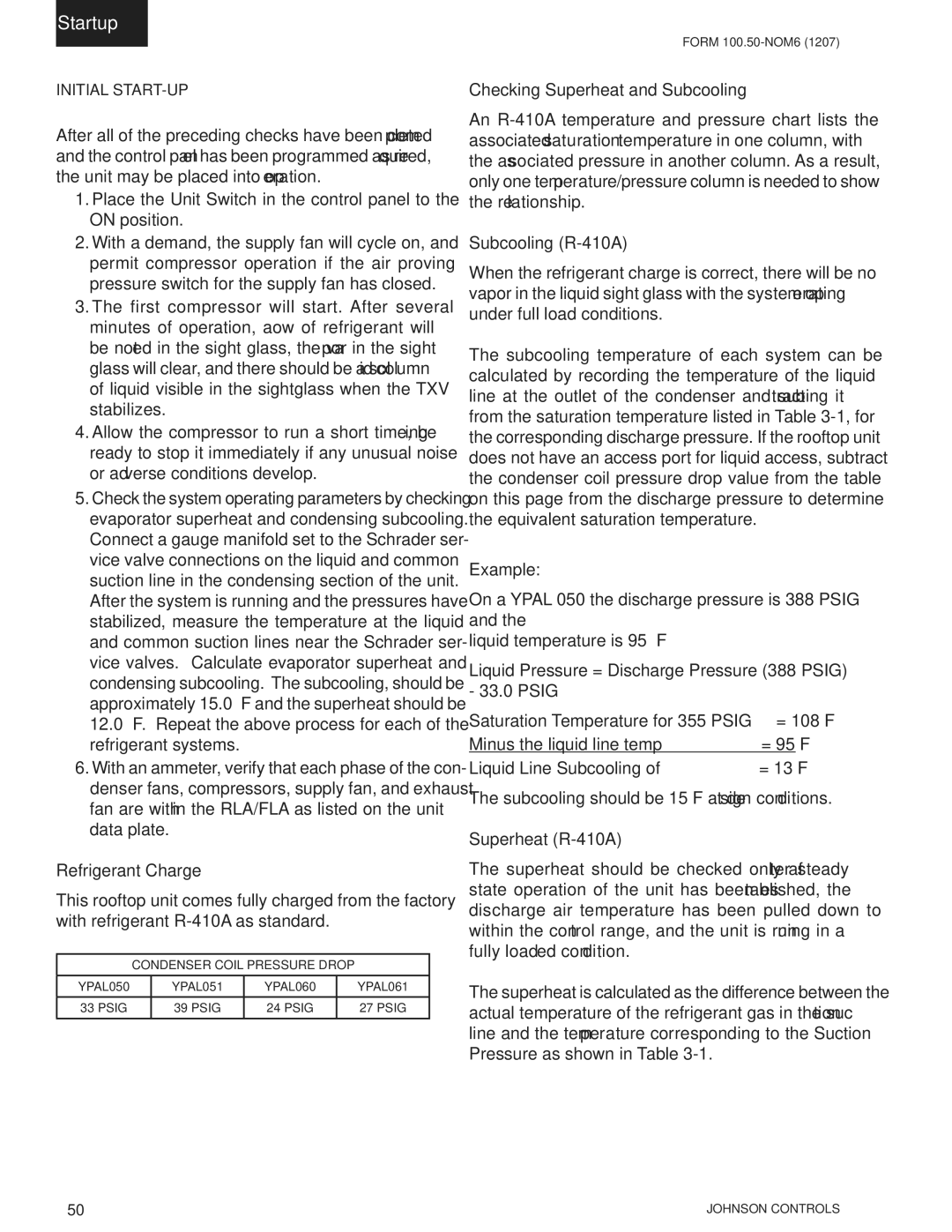
Startup
INITIAL START-UP
After all of the preceding checks have been completed and the control panel has been programmed as required, the unit may be placed into operation.
1.Place the Unit Switch in the control panel to the ON position.
2.With a demand, the supply fan will cycle on, and permit compressor operation if the air proving pressure switch for the supply fan has closed.
3.The first compressor will start. After several minutes of operation, a flow of refrigerant will be noted in the sight glass, the vapor in the sight glass will clear, and there should be a solid column of liquid visible in the sightglass when the TXV stabilizes.
4.Allow the compressor to run a short time, being ready to stop it immediately if any unusual noise or adverse conditions develop.
5.Check the system operating parameters by checking evaporator superheat and condensing subcooling. Connect a gauge manifold set to the Schrader ser- vice valve connections on the liquid and common suction line in the condensing section of the unit. After the system is running and the pressures have stabilized, measure the temperature at the liquid and common suction lines near the Schrader ser- vice valves. Calculate evaporator superheat and condensing subcooling. The subcooling, should be approximately 15.0 ˚F and the superheat should be 12.0 ˚F. Repeat the above process for each of the refrigerant systems.
6.With an ammeter, verify that each phase of the con- denser fans, compressors, supply fan, and exhaust fan are within the RLA/FLA as listed on the unit data plate.
Refrigerant Charge
This rooftop unit comes fully charged from the factory with refrigerant
CONDENSER COIL PRESSURE DROP
YPAL050 | YPAL051 | YPAL060 | YPAL061 |
33 PSIG | 39 PSIG | 24 PSIG | 27 PSIG |
FORM
Checking Superheat and Subcooling
An
Subcooling (R-410A)
When the refrigerant charge is correct, there will be no vapor in the liquid sight glass with the system operating under full load conditions.
The subcooling temperature of each system can be calculated by recording the temperature of the liquid line at the outlet of the condenser and subtracting it from the saturation temperature listed in Table
Example:
On a YPAL 050 the discharge pressure is 388 PSIG and the
liquid temperature is 95 °F
Liquid Pressure = Discharge Pressure (388 PSIG) - 33.0 PSIG
Saturation Temperature for 355 PSIG | = 108°F | |
Minus the liquid line temp | = 95°F |
|
Liquid Line Subcooling of | = 13°F | |
The subcooling should be 15°F at design conditions.
Superheat (R-410A)
The superheat should be checked only after steady state operation of the unit has been established, the discharge air temperature has been pulled down to within the control range, and the unit is running in a fully loaded condition.
The superheat is calculated as the difference between the actual temperature of the refrigerant gas in the suction line and the temperature corresponding to the Suction Pressure as shown in Table
50 | JOHNSON CONTROLS |
